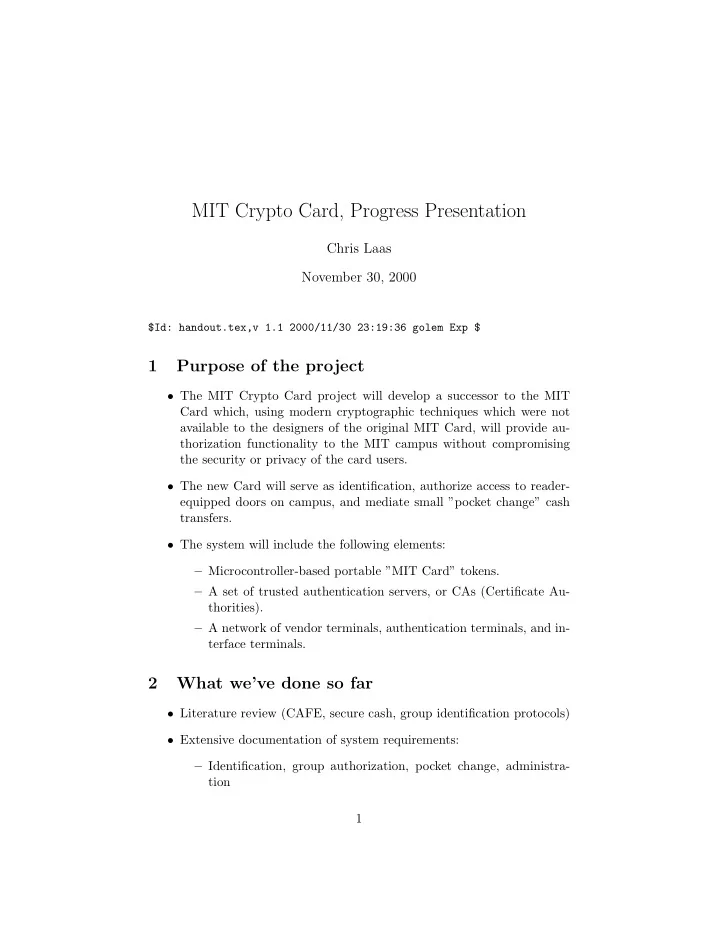

MIT Crypto Card, Progress Presentation Chris Laas November 30, 2000 $Id: handout.tex,v 1.1 2000/11/30 23:19:36 golem Exp $ 1 Purpose of the project • The MIT Crypto Card project will develop a successor to the MIT Card which, using modern cryptographic techniques which were not available to the designers of the original MIT Card, will provide au- thorization functionality to the MIT campus without compromising the security or privacy of the card users. • The new Card will serve as identification, authorize access to reader- equipped doors on campus, and mediate small ”pocket change” cash transfers. • The system will include the following elements: – Microcontroller-based portable ”MIT Card” tokens. – A set of trusted authentication servers, or CAs (Certificate Au- thorities). – A network of vendor terminals, authentication terminals, and in- terface terminals. 2 What we’ve done so far • Literature review (CAFE, secure cash, group identification protocols) • Extensive documentation of system requirements: – Identification, group authorization, pocket change, administra- tion 1
– Scaling requirements – Management and administration — decentralization of control, data quality, data privacy policies • Evaluated hardware: – Several smart cards (e.g. Gemplus): the market is rather homo- geneous. – iKey: advantage is form factor, compatibility, and LED; disad- vantage is reliability (sturdiness) – Gemplus CAFE token: Gemplus never turned them into a real product, but perhaps could be convinced to make a new proto- type. – PDAs: Still too expensive. Give it a few years? • Protocol and system design: – Identification protocols ∗ Researched options; will take one that works ”out of the box.” ∗ Fiat-Shamir is current default. ∗ Modular ”pluggable” part of system. – Cash protocols ∗ Researched options; there is a great variety. ∗ Will choose a conservative, but flexible design. ∗ This module is a low priority — authentication comes first. – Group authorization protocols ∗ Researched existing protocols — none provide anonymity and revocation. ∗ Designed a new system and set of protocols. · Heavily based on Ohta, Okamoto, and Koyama’s system [OOK90], which is heavily based on Chick and Tavares’s system [CT89]. A few minor changes to support anonymity were made, and a system to provide revocation function- ality was built on top of it. · Security rests on the RSA assumption. – CA and key management protocols 2
∗ Resilient and simple certificate management hierarchy, based on standard models. • Results of independent interest: – New privacy-preserving practical group authorization protocols. – Formulation of the problem of ”identity escrow”. 3 Plans for the immediate future • Hire someone! Talent with free time is hard to find and retain. • IAP: Concretize the protocols in preparation for review. • End of IAP: Submit protocols for review. • Spring: Begin software prototypes. • Where have the plans changed? – We are taking a much more conservative view of hardware than we initially envisioned. Given budget constraints, we will have to work with some primarily off-the-shelf system; this also means that the technology we will have available is less predictable. Hence, the protocols we design have more of an emphasis on tech- nology agnosticism. In addition, there is more of an emphasis on flexibility, as we cannot predict what will be the best platform options in a decade. 4 Long term plans • Hire someone! – In general, increase the size of the core group. Must find good systems programmers and good network programmers. – Also, work on increasing the budget. Budget will have a direct effect on ability to hire talent. • Technical plans – (ongoing) Keep an eye on hardware developments. 3
∗ consider likely technology developments: e.g. pan-campus wireless Ethernet coverage, advanced PDAs, more embedded computation. – Finish software prototypes. – Audit software. – Port software to hardware embodiments. – Set up a demo cluster. • Documentation – Write design documentation, technical specs, and manuals for the modules of the system. – Document operations of the system, including contingency plans. 4
Recommend
More recommend